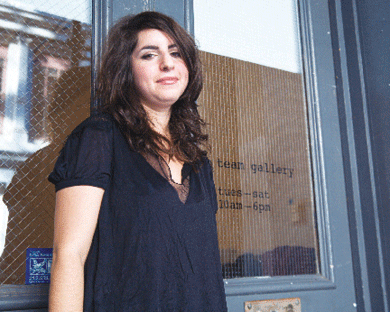By Stephanie Murg
The noodling, D-flat riff of Gun’s N’ Roses’ 1988 hit “Sweet Child O’Mine” greeted visitors to the inaugural exhibition of Team gallery last month, which relocated from Chelsea to Soho in September. Like the return of art to an area that has been colonized by luxury retail, the looped video clip projected on the white wall — “Sweet 16,” by Cory Arcangel — was at once familiar and disorienting.
While many of the art scene’s key players have moved to Chelsea, where over 300 galleries now jostle for space, Soho has retained its gallery-friendly feel, even if Team’s neighbors are more likely to sell $30,000 purified Argentinean horsehair mattresses (Hästens, 80 Greene St.) and hand-sculpted obsidian glass sex toys (Kiki de Montparnasse, 79 Greene St.) than paintings and sculptures.
For Team, owned by Jose Friere and specializing in emerging artists such as Arcangel, moving from Chelsea was not so much a deliberate choice as a question of finding the best available space as their ten-year lease in Chelsea neared expiration. “In Chelsea, there was a lot of competition — a landlord would talk to us seriously about a space but had already rented it out,” says gallery director Miriam Katzeff. “It was a hectic experience, so we started looking in Soho.”
When asked whether Team’s move is a harbinger of a broader geographical shift in the New York art scene’s, Katzeff doesn’t foresee an imminent Chelsea exodus. “I wouldn’t say that Chelsea has seen its heyday,” she says. “I think most galleries in Chelsea will remain in Chelsea. New galleries will probably continue to open in the Lower East Side, but maybe some will also move to Soho now.”
The move is something for a homecoming for Friere, who owned Jose Friere Fine Art on Prince Street before founding Team in 1996. Team’s new home is a cavernous ground-floor space on Grand Street between Greene and Houston that was once a design store and before that, an art gallery. But it wasn’t love at first sight. “We had to gut it and rebuild it, but the proportions, the high ceilings, the light, and the fact that there are two different exhibition rooms made it appealing,” says Katzeff. “Our old space was a basement — low ceilings, no light, uneven floors, pretty much everything you wouldn’t want in a gallery.”
Although construction is ongoing, the Arcangel show demonstrated the space’s ability to showcase multiple large-scale works without feeling cramped or empty. Now on view at Team through December 23 is “The Abandonments,” six new videos by Slater Bradley, whose work has been exhibited at such venues as the Whitney and the Guggenheim. Bradley, 31, is best known for his photo and video works that feature “the doppelganger,” a chameleonlike man named Benjamin Brock who has appeared, in guises ranging from Kurt Cobain to a turn-of-the-century dandy, as the subject and object in Bradley’s works of the past seven years.
A standout work in the Bradley show is “My Conclusion, My Necessity” (2005-06), which follows a young girl and her mother as they visit the grave of Oscar Wilde in Paris’s Père Lachaise Cemetery. The application of lipstick as the girl prepares to add the mark of her kiss to the others on Wilde’s headstone is a riveting ritual.
While Team shows a lot of video art, the diverse roster of artists, which also includes Ryan McGinley, Lisa Ruyter, and Banks Violette, is difficult to pigeonhole. “We’re willing to take risks,” says Katzeff, when asked to characterize Team. She uses Arcangel as an example of the kind of artist they’re drawn to. A few years ago, he made a splash with his “hacked” Nintendo video game chips. In these works, he altered the 8-bit landscapes of games such as Super Mario Bros., removing all of the characters and leaving the cloud-studded blue sky that somehow remained instantly recognizable as Marioland.
“When Cory [Arcangel] first started showing, it wasn’t clear what a hacked Nintendo video game would be in ten years. Would it still function? Would the piece degrade? But if you see that an artist is doing something and it makes you stop and think, then maybe it’s worth the risk.”
Team’s move to Soho has come with benefits beyond the space itself. For example, visitors tend to be more purposeful and interested. “When people come they stay longer, because they don’t have 50 other galleries on the block that they have to go see,” says Katzeff. “People make a special trip because they have an interest in something that we’re showing.”
And of course, Team’s new neighborhood also bests Chelsea in another important aspect: lunch. “Don’t get me wrong, I like Bottino, but I usually grab my lunch and then come back to the gallery,” says Katzeff, who favors the Sullivan Street Bakery and Gourmet Garage. “So now I have a lot of choices. It’s such a small, petty thing, but it makes a big difference.

































